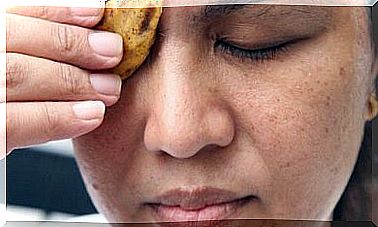The Benefits And Risks Of Holotropic Breathing

Good, calm and correct breathing provides many benefits for body and mind. Most people know this, but not everyone has heard of holotropic breathing and its benefits.
This is a compound term formed from the Greek words holos (meaning “everything”) and tropos (“movement”). Therefore, the word could be translated as “moving into wholeness”.
Holotropic breathing seeks to achieve an altered state of consciousness to achieve self-healing, breaking through fears, blocks, and other emotional issues. The belief is that healing comes from within the person.
What is holotropic breathing?
The technique of holotropic breathing was developed in the 1970s by Czech psychiatrists Stanislav and Christina Grof, although the technique is based on the knowledge of ancient cultures. It is a natural and simple method of improving well-being that uses hyperventilation in combination with music.
Breathing at a very fast pace for a period of time changes the balance between carbon dioxide and oxygen in the body. Therefore, the aim is to accelerate breathing patterns in a controlled manner, attempting to reach non-ordinary states of consciousness for therapeutic purposes.
According to technology experts, when prompted by breathing and music, people can even visualize hidden experiences from their past. This would serve for a deeper understanding of the self.
The holotropic breathing process

A holotropic breathing session lasts 2 to 3 hours. It can be done in groups or individually. When working in groups, people meet in pairs, alternating in the role of the exerciser or the facilitator. The latter’s job is to guide the person doing the holotropic breathing, without interfering in the process.
- Both individual sessions and group sessions should also include a trained facilitator as the person responsible for everything. This person provides support during the exercise and ensures that the process is safe.
- The facilitator guides the session and gives instructions to increase the breathing rate. And even if it is increased, the rhythm must remain constant, fast and even.
- At the same time, music is an essential part of holotropic breathing. The sounds are like those of meditation, with monochord rhythmic patterns.
- Sessions are usually open ended, in the sense that there is no preconceived idea or expectation about what content of the psyche to explore during the session. Each person derives its own meaning and achieves self-discovery of the problem.
The goal is for holotropic breathing to be a catalytic experience, to bring hidden events to the surface of consciousness. In some cases, especially in individual therapy, the participant(s) and the facilitator will then comment or discuss them.
Potential Benefits of Holotropic Breathing
People who practice and recommend holotropic breathing claim that it offers several benefits. These would be physical, mental and emotional. So let’s take a closer look at what those are.
Relaxation
Many people do breathing exercises to relax. Although in the holotropic modality the rhythm increases, you still achieve serenity. However, this is more due to the emotional experience.
Negative thoughts
People who practice holotropic breathing claim that they use this technique to control or dispel negative thoughts. It is a way to reduce pessimism and even reduce anxiety at the thought of death.
Negative emotions
The evidence found suggests that holotropic breathing could also be helpful for self-control. It could be especially helpful in people who are prone to mood swings or who have negative attitudes.
Fear and self-esteem
In a clinical study using holotropic breathing in combination with other techniques, participants significantly increased their self-esteem levels and showed a greater decrease in anxiety. This was compared to those who received psychotherapy alone.
Emotional Healing Through Holotropic Breathing
A 2013 study documented sessions of people participating in frequent holotropic breathing sessions over several years. The results suggest that this technique could be useful for achieving emotional stability.
Self awareness
A 2015 study found that holotropic breathing can generate higher levels of self-awareness, while also being useful for encouraging positive changes in behavior.
In addition, proponents of holotropic breathing claim that this technique allows people to access hidden contents of the mind. It could therefore help to bring unresolved past situations to the surface.
In this way, through holotropic breathing, people can unblock certain experiences in the hope of freeing themselves from emotional problems. This can help them overcome trauma and phobias, as well as psychosomatic disorders.
Risks and Contraindications

While the technique is simple, it is not without risks and potential negative effects. For example, the imbalance between carbon dioxide and oxygen levels can lead to a condition called respiratory alkalosis.
It is therefore not uncommon for various symptoms to appear, such as tingling or numbness in the extremities and mouth, dizziness, lightheadedness, weakness, fainting, spasms and even convulsions.
That is why it is important to take precautions regarding the possible risks. For this reason, experts warn against holotropic breathing if the person has an ailment or condition, such as the following:
- Arterial hypertension
- angina pectoris
- Heart failure
- Cardiac arrhythmias
- Glaucoma
- retinal detachment
- Panic attacks
- Convulsions
Always be careful with holotropic breathing
According to claims, holotropic breathing can bring to light certain past experiences and thus provide a transformative experience. However, in some people, this discovery of wounds can cause uncomfortable and unpleasant feelings.
If you want to try the technique, it is important that you look for someone who has been trained for this. They must adequately supervise the process and intervene in the event of any complications.
Finally, it is important to make it clear that you should see this as an additional treatment and not as a replacement for professional treatment. Thus, it can help complement other techniques and psychological sciences practiced by professionals.









